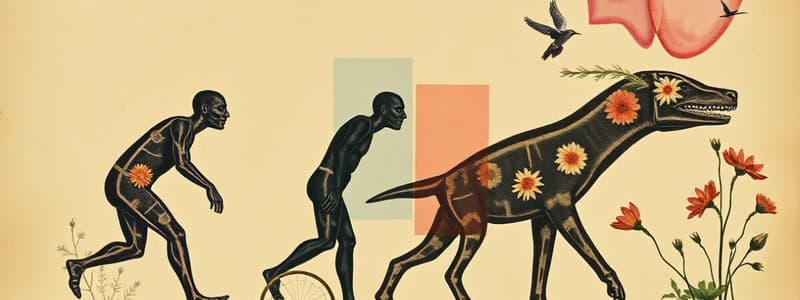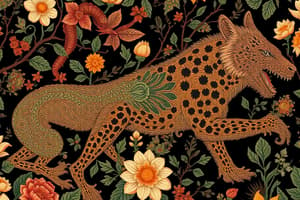Podcast
Questions and Answers
Which statement best describes the change in the peppered moth population after the industrial revolution?
Which statement best describes the change in the peppered moth population after the industrial revolution?
- Light-colored moths became more common.
- Both types of moths became equally common.
- The color of the moths did not change.
- Dark-colored moths became more common. (correct)
The light-colored peppered moths were favored by natural selection before the industrial revolution.
The light-colored peppered moths were favored by natural selection before the industrial revolution.
True (A)
What phenomenon explains the increase in dark-colored peppered moths after the industrial revolution?
What phenomenon explains the increase in dark-colored peppered moths after the industrial revolution?
Natural selection
Before the industrial revolution, most peppered moths were of the ______ form.
Before the industrial revolution, most peppered moths were of the ______ form.
Match the terms with their definitions:
Match the terms with their definitions:
Lamarck's theory of evolution suggests that traits acquired during an organism's lifetime can be [blank] to its offspring. What is this process called?
Lamarck's theory of evolution suggests that traits acquired during an organism's lifetime can be [blank] to its offspring. What is this process called?
Mutagens are factors that can cause changes in the genotype of an organism.
Mutagens are factors that can cause changes in the genotype of an organism.
What caused the dark-colored moths to have a survival advantage during the Industrial Revolution?
What caused the dark-colored moths to have a survival advantage during the Industrial Revolution?
Light-colored moths were less likely to survive and reproduce in an industrial environment.
Light-colored moths were less likely to survive and reproduce in an industrial environment.
What effect did the dark-colored moths have on the genetics of their offspring?
What effect did the dark-colored moths have on the genetics of their offspring?
The phenomenon where darker moths thrived due to pollution is an example of __________.
The phenomenon where darker moths thrived due to pollution is an example of __________.
Match the terms related to genetics with their definitions:
Match the terms related to genetics with their definitions:
Which of the following statements aligns best with the concept of Lamarck's theory?
Which of the following statements aligns best with the concept of Lamarck's theory?
The dark and light-colored moths are an example of different genotypes in the same environment.
The dark and light-colored moths are an example of different genotypes in the same environment.
What role did the Industrial Revolution play in the evolution of the peppered moth?
What role did the Industrial Revolution play in the evolution of the peppered moth?
The percentage of dark moths in the population __________ over time due to selective pressures.
The percentage of dark moths in the population __________ over time due to selective pressures.
What is the main concept behind Lamarck's theory of evolution?
What is the main concept behind Lamarck's theory of evolution?
Darwin's observations of finches in the Galapagos Islands led him to develop the theory of inheritance of acquired characteristics.
Darwin's observations of finches in the Galapagos Islands led him to develop the theory of inheritance of acquired characteristics.
What is the difference between genotype and phenotype?
What is the difference between genotype and phenotype?
The process through which organisms with advantageous traits survive and reproduce more effectively is known as _____ selection.
The process through which organisms with advantageous traits survive and reproduce more effectively is known as _____ selection.
Match the following terms with their correct definitions:
Match the following terms with their correct definitions:
Which of the following best explains the peppered moth example of evolution?
Which of the following best explains the peppered moth example of evolution?
Natural selection always results in more complex organisms.
Natural selection always results in more complex organisms.
Name the ship Darwin was aboard during his voyage that led to his observations of natural selection.
Name the ship Darwin was aboard during his voyage that led to his observations of natural selection.
______ characteristics are traits that can be passed from parents to offspring through genes.
______ characteristics are traits that can be passed from parents to offspring through genes.
What key factor did Darwin identify as influencing which organisms survive and reproduce?
What key factor did Darwin identify as influencing which organisms survive and reproduce?
Flashcards
Peppered Moth Forms
Peppered Moth Forms
The peppered moth is a common insect in Britain with two forms: the dark form and the light form.
Light Form
Light Form
The light form of the peppered moth has a speckled white and black coloration, resembling the lichen covered trees.
Dark Form
Dark Form
The dark form of the peppered moth is darker in color, mimicking the soot-stained tree bark.
Peppered Moth Before Industrial Revolution
Peppered Moth Before Industrial Revolution
Signup and view all the flashcards
Peppered Moth After Industrial Revolution
Peppered Moth After Industrial Revolution
Signup and view all the flashcards
Natural Selection in Peppered Moths
Natural Selection in Peppered Moths
Signup and view all the flashcards
Variation in Species
Variation in Species
Signup and view all the flashcards
Evolution
Evolution
Signup and view all the flashcards
Heritable characteristics
Heritable characteristics
Signup and view all the flashcards
Biological population
Biological population
Signup and view all the flashcards
Adaptations
Adaptations
Signup and view all the flashcards
Lamarck's Theory
Lamarck's Theory
Signup and view all the flashcards
Natural Selection
Natural Selection
Signup and view all the flashcards
Natural Selection
Natural Selection
Signup and view all the flashcards
Variation
Variation
Signup and view all the flashcards
Survival of the Fittest
Survival of the Fittest
Signup and view all the flashcards
Population
Population
Signup and view all the flashcards
Genetic variation
Genetic variation
Signup and view all the flashcards
Selective pressure
Selective pressure
Signup and view all the flashcards
Differential survival
Differential survival
Signup and view all the flashcards
Differential reproduction
Differential reproduction
Signup and view all the flashcards
Evolutionary change
Evolutionary change
Signup and view all the flashcards
Study Notes
Evolution
- Evolution is the change in heritable characteristics of biological populations over successive generations.
- Heritable characteristics are inherited via genes from parents.
- Biological populations are members of a single species in a common location at a common time.
- Evolution often results in adaptations that increase an organism's chance of survival in its environment.
Lamark's Theory (1809)
- Lamark's theory proposed "inheritance of acquired characteristics," meaning organisms could develop traits during their lives and pass those traits onto their offspring.
- His theory didn't include genetic characteristics; traits acquired during an organism's life cannot be passed down to the next generation.
Darwin (1859)
- Darwin was a naturalist who observed variations in finches on the Galapagos Islands.
- He noticed variations in beak shape and size among finches, suggesting adaptation to different food sources.
- He developed the theory of natural selection.
- Natural selection proposes a mechanism for evolution.
Natural Selection
- Variation exists within a population. This variation, caused by mutations, is what allows natural selection to take place.
- There is a struggle for survival, often due to competition for resources.
- Individuals better adapted to their environment are more likely to survive and reproduce, passing their favorable traits to their offspring.
- Over time, the advantageous characteristics become more prevalent in the population, driving the evolution of organisms.
Genes and Variation
- DNA is the instruction book for traits
- DNA is arranged into chromosomes, which come in pairs.
- The number of chromosome pairs varies between species.
- Genes code for proteins, the building blocks of life.
- Variation in genes, called alleles, leads to different traits.
- Alleles arise from mutations.
- Mutations can cause variation in traits.
- Some mutations can be positive, neutral, or negative. Positive mutations increase an organism's fitness, neutral mutations have no effect, negative mutations are detrimental to an organism.
- Traits are often polygenic; meaning they are influenced by many genes
- Examples of single gene traits are widows peak, tongue-rolling, attached earlobes.
- Examples of polygenic traits are height, eye color.
Sources of Variation
- Mutations: changes in the arrangement of bases of our individual genes
- Sexual reproduction: creates genetic variation through crossing over during meiosis and random assortment of chromosomes.
Genetic Definition of Evolution
- A change in the relative frequency of alleles in a population.
Examples of Evolution
- Peppered moths: demonstrates natural selection in response to environmental change. There is variation in color in peppered moth populations. During the Industrial Revolution, soot from pollution darkened tree bark, making dark moths less visible to predators, leading to an increase in the frequency of dark moths in the population.
Studying That Suits You
Use AI to generate personalized quizzes and flashcards to suit your learning preferences.
Related Documents
Description
Explore the fundamental concepts of evolution, including the heritable characteristics of populations and the theories proposed by Lamarck and Darwin. Understand how adaptations occur and the significance of natural selection in the evolution of species.




